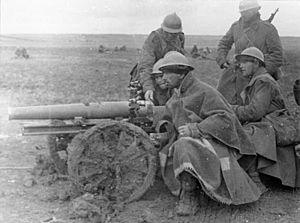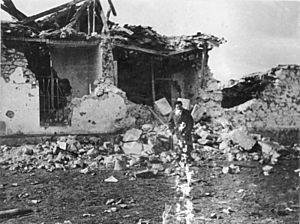Battle of Guadalajara facts for kids
Quick facts for kids Battle of Guadalajara |
|||||||
|---|---|---|---|---|---|---|---|
| Part of the Spanish Civil War | |||||||
 Nationalist forces at Guadalajara |
|||||||
|
|||||||
| Belligerents | |||||||
| Commanders and leaders | |||||||
| Strength | |||||||
45 artillery pieces 70 armoured vehicles 80 aircraft |
270 artillery pieces 140 armoured vehicles 62 aircraft |
||||||
| Casualties and losses | |||||||
| Republicans: 2,000 dead 4,000 wounded 400 captured |
Italians: 3,000 dead 4,000 wounded 800 missing 800 captured 65 artillery pieces 500 machine guns 13 mortars 67 trucks Plenty ammunition 10 tanks captured Nationalists: 4,000 dead 4,000 wounded 800 captured |
||||||
The Battle of Guadalajara happened from March 8 to 23, 1937. It was a big win for the Spanish Republican Army and the International Brigades. They fought against Italian and Nationalist forces. These forces were trying to surround Madrid, the capital city of Spain, during the Spanish Civil War. Most of the Nationalist forces in this battle were Italian volunteers called the Corpo Truppe Volontarie (CTV).
The battle started with an Italian attack on March 8. This attack was stopped by March 11. From March 12 to 14, the Italians attacked again, with help from Spanish Nationalist units. These attacks were also stopped. On March 15, the Republicans got ready to fight back. They launched their own attack from March 18 to 23 and won.
Contents
Why the Battle Happened
After failing to capture Madrid three times, the Nationalist General Francisco Franco wanted to try again. He planned a fourth attack to surround the capital. His forces were tired after a tough fight at the Battle of Jarama. But the Italians felt confident after capturing Málaga. They thought it would be an easy win because the Republican army had lost many soldiers at Jarama. Italy's leader, Benito Mussolini, agreed and sent Italian troops to help.
The Italian commander, General Mario Roatta, planned to attack Madrid from the north-east. His goal was to meet up with Spanish Nationalist troops near the Jarama River. The main attack would be carried out by the Italian forces. A Spanish division was there to help, but they didn't join the fighting for the first five days.
The main attack happened in a 25-kilometer wide area near Guadalajara. This area was good for an attack because it had five good roads. Three other roads led to Guadalajara itself, making it possible to capture the town. The Nationalist forces had about 35,000 soldiers. They also had many weapons: 222 artillery pieces, 108 small tanks called tankettes, 32 armored cars, and 60 fighter planes.
The Republican forces in the Guadalajara area were much smaller. They had only about 10,000 soldiers, 85 machine guns, and 15 artillery pieces. They also had some T-26 light tanks. There were no defenses built in Guadalajara. The Republicans thought the next attack would come from the south, so they weren't ready for a fight there.
Italian Attack Begins
March 8: First Push
The battle started with 30 minutes of artillery fire and air raids on Republican positions. Then, Italian troops, led by their small tanks, broke through the Republican lines. But their attack slowed down because of thick fog and sleet. It was hard to see more than 100 meters. The Italians still managed to capture about 10 to 12 kilometers of land. This included the towns of Mirabueno, Alaminos, and Castejon. The Republican commander asked for more soldiers and tanks.
March 9: Slow Advance
The Nationalist forces kept attacking. Their main attack used tanks, but it was again slowed by bad weather and poor visibility. The Republican 50th Brigade managed to escape without a fight. Around noon, the Italian advance was stopped by soldiers from the XI International Brigade. These were volunteers from countries like Germany, France, and the Balkan countries. The Italians had gained another 15 to 18 kilometers of land. They captured towns like Almadrones, Cogollor, and Masegoso. By evening, some Italian troops reached the edge of Brihuega. They stopped there to rest and wait for a bigger gap in the Republican lines. This pause was needed for the soldiers to recover.
By the end of this day, the Republicans had about 1,850 soldiers, 34 machine guns, 6 artillery pieces, and 5 tanks. More help was on the way.
March 10: International Brigades Hold the Line
The Republican forces got more help. This included Italian and Polish soldiers from the XII International Brigade (including the Giuseppe Garibaldi Battalion). They also received more artillery and tanks. The Republicans now had 4,350 soldiers, 8 mortars, 16 artillery pieces, and 26 light tanks.
In the morning, the Italian Nationalist forces launched heavy attacks with artillery and planes. They tried to break through the lines of the XI International Brigade but failed. At this point, the Nationalists had 26,000 soldiers, 900 machine guns, and 130 light tanks. They captured the towns of Miralrio and Brihuega. Brihuega was taken almost without a fight.
The Nationalist attacks on the International Brigades continued all afternoon but still failed. At Torija, they met the Italian Garibaldi Battalion. During the fight, the Garibaldi Battalion encouraged the Fascist soldiers to join the Republicans. The attacks stopped in the evening, and the Italian Nationalist units built defenses.
March 11: Nationalist Gains
The Italians made a successful advance against the XI and XII International Brigades. These Republican units had to fall back along the main road. The leading Italian troops were stopped about 3 kilometers before the town of Torija. The Spanish Nationalist division "Soria" captured the towns of Hita and Torre del Burgo.
Republican Counterattacks
March 12: Air Power Changes the Battle
The Republican forces, led by Líster, moved their troops in the morning. They launched a counterattack at noon. About 100 Republican fighter planes and two squadrons of bombers were ready at the Albacete airfield. The Italian planes were stuck on muddy airfields because of the rain. But the Republican airfield had a concrete runway, so their planes could take off.
After bombing the Italian positions, Republican soldiers, supported by T-26 and BT-5 light tanks, attacked the Italian lines. Many Italian tankettes got stuck in the mud when General Roatta tried to move them. They became easy targets for the Republican planes. The Republican advance reached Trijueque. An Italian counterattack failed to win back the lost land.
March 13: Planning the Next Move
The Republican counterattack on Trijueque was successful. The plan was to focus the 11th Division and all armored units on the Zaragoza road. Meanwhile, the 14th Division would cross the Tajuña River to attack Brihuega. The Italians were warned about this plan but didn't listen to advice from the Spanish chief of operations.
March 14–17: Preparing for the Big Push
On March 14, most Republican soldiers rested. Their air force continued successful attacks. The International Brigade captured the Palacio de Ibarra. In the next few days, the Republicans moved their troops and gathered their forces.
The Republican forces now had about 20,000 soldiers, 17 mortars, 28 artillery pieces, 60 light tanks, and 70 planes.
The Italian and Spanish Nationalist forces had about 45,000 soldiers, 70 mortars, 200 artillery pieces, 80 small tanks, and 50 planes.
March 18: The Main Counterattack
At dawn, Vicente Rojo gave the orders. Mera led the 14th Division across a temporary bridge over the Tajuña River. Heavy sleet helped hide their movement, but it also slowed their attack. After midday, the weather got better, allowing the Republican air force to fly. Around 1:30 PM, Jurado gave the order to attack. Líster's advance was slowed by the Italian Littorio Division, which was considered one of Italy's best units. The 14th Division almost surrounded Brihuega, and the Italians retreated in a panic. The remaining Italian soldiers were cleared out by the XI International Brigade.
An Italian counterattack on Republican positions failed. It was pushed back by the Assault Guard Division, one of the best Spanish Republican units. This attack caused heavy losses for the Italians. The Littorio Division helped save the Italians from a complete disaster by organizing a good retreat.
March 19–23: Final Push and Stop
The Republican forces took back the cities of Gajanejos and Villaviciosa de Tajuña. Their counter-offensive finally stopped along the Valdearenas–Ledanca–Hontanares line. This was because Franco had sent more troops to create a new defense line there.
What Happened After
The Battle of Guadalajara was a very important victory for the Republican Army. It greatly boosted their spirits. Some people even compared it to a famous defeat of Napoleon, saying it was a big blow to Fascism. The British newspapers made fun of it, calling it a "new Caporetto" (a big Italian defeat in World War I).
The Italian CTV lost about 3,000 men. The Spanish Nationalists had fewer losses. The Republican army also captured many needed supplies. These included 65 artillery pieces, 500 machine guns, 67 trucks, 13 mortars, and 10 tanks.
More importantly, the Republican victory stopped Madrid from being surrounded. This ended Franco's hopes of winning the war quickly by taking the capital. Franco then decided to change his plan. He would try to take Republican areas one by one, starting in the north.
Guadalajara was a big blow to Italy's pride and its Fascist government. Their leader, Mussolini, had sent the Italian army hoping to show off Italy's "iron military strength." Because of this defeat, Franco (who didn't want the Italian army to win the war by itself) decided to spread the Italian troops among Spanish Nationalist units. This didn't fully happen, but Guadalajara made Mussolini want to win even more to make up for the embarrassment.
Franco was actually a bit happy about his allies' humiliation. He didn't want the Italian CTV to win the war alone, as he thought it would make it seem like a foreign army won Madrid. Officers in General Moscardó's headquarters even celebrated "Spanish heroism, of whatever color." This was probably the only time Nationalist forces cheered for a Republican victory. Franco's soldiers even sang popular Italian songs with new words making fun of the defeated Italian troops. One song joked that the Italians needed "fewer trucks and more courage."
Some believe the CTV lost the battle because Franco did not start a side attack as he had promised. When the Nationalists didn't attack, the Republicans could move their troops to meet the Italian offensive. It's possible Franco used the Italian troops to gain time for his own tired soldiers to regroup. This might explain why there were ungrateful songs against the Italians, even though they helped the Nationalist cause a lot.
See also
 In Spanish: Batalla de Guadalajara (1937) para niños
In Spanish: Batalla de Guadalajara (1937) para niños
- List of Spanish Republican military equipment of the Spanish Civil War
- List of weapons of the Corpo Truppe Volontarie
- List of Spanish Nationalist military equipment of the Spanish Civil War
Images for kids





